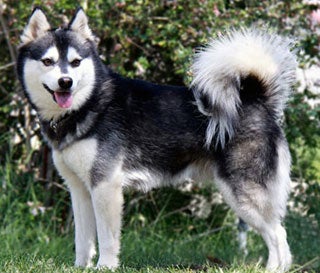Learn about dog breeds
Detailed information & photos on over 190 different breeds
Description
Dogs from the northern areas have a tendency to look like the huskies--regardless whether they are the Alaskan Husky or the Siberian. All originate from the members of the Spitz-dog family, which is where the Alaskan Klee Kai comes in.
Dogs that have Spitz in their background have long and thick hair with pointed ears and muzzles. Curved over their back is their trademark tail, usually curled when they are alert and excited about something. Wedge-shaped heads are offset by a noticeable full-masked face, pricked ears, and a double-coat to ensure warmth and protection from the extreme elements.
Coat Description
The appearance of the Alaskan Klee Kai says a lot about its northern heritage, especially with its soft undercoat and firm guard hair of its outer coats. Designed to only be available during the wintry times of the year, they are not available during the hot shedding summers. Twice a year they blow their coat, to remove the extra hair and dead skin.
In this breed, many colors are available--shades of gray-and-white, white-and-black or the very scarce red-and-white breeds of which there are only five red AKK dogs recognized today. Every one of these colors and color combinations are acceptable, as long as the face mask is highly visible and stands out with a light shade on the underside, throat, chest, feet, and legs.
The mask is considered to be the highlight of the breed, with a dark shade on the head that extends toward the muzzle while gently coloring the area under the eyes. Also, inside the dog's ears should have a lighter shade or more of a contrasting color.
History
The U.S. State of Alaska gave the breed its origin, along with the help of Linda Spurlin in the later 70s. She had become very attached to a puppy that had been born to a smaller unknown breed and the Alaskan Husky. After that, she worked on developed a breed of this companion of hers, without getting the dwarfism that occasionally would develop.
She experimented with a series of crossbreeding between Siberian and Alaskan Huskies, in addition to the Schipperke and American Eskimo Dogs. This "new breed" was called the Klee Kai, with its new name of the Alaskan Klee Kai formed in 1995. They were recognized by the ARBA (American Rare Breed Association) that very same year and the UKC (United Kennel Club) in 1997.
Temperament
Naturally very reserved with strangers and other dogs, this is the type of breed that needs to be socialized at a very young age. A dog that has been bred for companionship only, they are excellent watchdogs in the sense they inform when someone is coming--they are not vicious and aggressive.
Obedience classes should be a mandatory thing for this breed due to their high energy, as exposure to other people, situations, and dogs are critical in addition to learning the basic steps of obedience. Otherwise, they have a tendency to become extremely fearful. Known as a talking breed, they have soft vocalizations as compared to many other breeds.
Health Problems
The Alaskan Klee Kai is a very strong and healthy breed, but there is great concern over a hereditary FVII bleeding disorder that has been known to affect it. A DNA testing has been developed for it at the University of Pennsylvania, trying to find which mutations is responsible. Otherwise, the breed is considered fine.
Grooming
Considered to shed within the normal range, the AKK requires a routine combing and brushing to keep the coat healthy. Depending on the dog, bathing should be done only when desperately needed--such as running in mud or swimming in salt water. When bathing, using special a shampoo should not cause skin-irritations or drying out of the dog's coat enough to get flaking.
The ears are another area of major concern, as it will build up wax, dirt and excessive hair. Cotton balls and baby oil can be used to clean this delicate area very carefully, or use special ear cleaning solutions that are available. Eyes need to be wiped if they are runny or dirty in the corners with debris. Nails need to be trimmed on a weekly basis, as they can become painful and ingrown.
Exercise
Exercise is always important to all breeds of dogs, but it is not quite an issue with the Alaskan Klee Kai as other huskies. This is due to the smaller size and gentle disposition, yet full of high-energy tactics. As they mature, this will slowly decrease, as they become mature with age.
If introduced as a young puppy, other breeds are acceptable in their lives, but they will need to enjoy running and playing as hard as the AKK does. Speed is part of who they are, and running so fast a soft blur is seen going around the yard is normal routine for their owners to see. Jogging and walking are excellent forms of exercise, chasing balls and tug rope--anything is acceptable as long as it involves a steady routine on a daily basis.
Training
Consistent training methods are required for the Alaskan Klee Kai, which involve steady commands with specific trainers. This is an intelligent breed, and smart enough to think on his or her own if they do not understand what their trainer/owner wants.
Age and training will improve as time goes on for the young puppy, with a minimum of one hour of training not too much if it is gentle and consistent. These perfect times could be after its nap, after found chewing on something it should not, after its favorite grooming exercise, and anytime that is acceptable.
Advertise | Privacy Policy | Terms of Use | Contact Us © Copyright 2004-2024 PupCity.com. All rights reserved.
